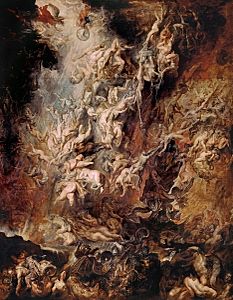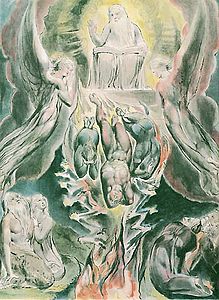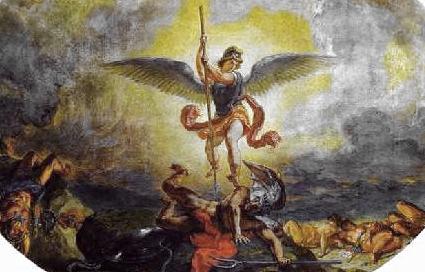Fall from hell

The fall from hell , also known as the angel fall , is a central motif mainly in Christian eschatology and the iconography of Christian art .
meaning
Fall into hell is understood to mean three fundamentally differentiated processes:
The fallen angel
In the New Testament , in Christian interpretations of the Old Testament as well as in apocryphal books and the Koran , the idea of an apostate angel is common. The angel is punished for his rebellion with the expulsion from heaven by God and his other angels. Often this fallen angel was then associated with Lucifer , Samael or the personified evil, with the title Satan , the devil , who according to Lk 10.18 EU is also said to have "fallen from heaven".
The reasons given for the fall of the angel are:
- Striving for equality with God: In the book of Isaiah (14.12–14 EU ) the king of Babylon - identified in Christian interpretations with an angel - is addressed who wanted to rise above God and went to hell for it. - In Umm al-kitāb , an Ismaili work from the 8th century , the archangel Asazel equates himself to Allah because of his ability to create his own worlds . This removes the angel's borrowed powers and banishes him to the lower spheres until he ends on earth.
- Proud: Ezekiel (28.12–18 EU ) mentions in his sermon against the King of Tire a “shining, shimmering cherub ” whose “heart rose for its beauty”. He then desecrated his sanctuary through "iniquity" and "wrong trade."
- Refusal to show respect for man: According to another teaching, God commanded his angels to kneel before man after the creation of man. But some angels refused, because man was made of lower material than they were. There is no biblical evidence for this version. Rather, it probably originated in the life of Adam and Eve , an apocryphal text from the 1st century AD. In him the devil confesses to Adam that he hates people because he was driven out of heaven because of them. In the Gospel of Bartholomew , an apocryphal gospel , it is described that Satan, because of his creation from fire, refuses to honor man made of matter. This also appears in the Koran. In sura 38 , 72 Iblis refuses to give man his reverence, since he was made of fire, but man was only made of clay; then he is banished.
- Free Will: After the church father Origen which they have been offered enticed free will some angels to remove more and more of God. As a result, some became people or even demons and therefore had to be driven out of heaven - not without the opportunity to return there through virtue and a godly life. Origen was u. a. almost excommunicated as a heretic because of these teachings .
- Lust: According to the apocryphal book of Enoch , it is sexual pleasure that brought about the fall of the angels. God commissioned the Grigori, a certain group of angels, to help the archangels create the Garden of Eden . Having descended on earth, however, they fell in love with the human daughters, revealed heavenly secrets to them and even fathered children with them, the giant race of the Nephilim (cf. also Gen 6.1 EU ). God was so angry about this that he expelled the Grigori from heaven, robbed them of their immortality and turned them into demons. The flood he sent last but not least, to extinguish the race of Nephilim. - A similar story can be found in Islamic exegesis in relation to the angels Harut and Marut mentioned in the Koran . After asking Allah to punish the sinfulness of the people, they were sent to earth in human form. There, seduced by the sexual desire for a woman, they succumbed to the sins of fornication and murder , whereupon they were refused a return to heaven.
These motifs also appear in mixed forms, for example in John Milton's epic poem Paradise Lost . There Satan and a third of the angels rebel against God after God installed his son as ruler. Satan and his allies are too proud to submit to the rule of God's Son. They are exercising their free will, disobeying God, and preparing to attack. Thereupon a three-day battle breaks out between the godly angels and the rebels, at the end of which God's Son, on God's behalf, drives the disobedient angels out of heaven and lets them fall into hell. After the Fall, Satan takes revenge by seducing those loved by God to eat the forbidden fruit from the tree of knowledge.
Defeat the devil in the apocalypse
While in the Christian tradition the stories of the fallen angels take place in the distant past and are often related to the creation of man, the Christian fall from hell motif can also refer the other way round to events in the apocalypse at the end of time :
In the Revelation of John ( Rev 12 : 3 ff. EU ) a dragon appears, often identified with the devil, with "seven heads and ten horns", which with its tail sweeps away a third of the stars and threatens to devour the woman's child . Thereupon a fight breaks out between the angels and the dragon: “A fight broke out in heaven; Michael and his angels rose to fight the dragon. The dragon and its angels fought, but they could not hold on and they lost their place in heaven. He was overthrown, the great dragon, the old serpent called the devil or Satan, who seduced the whole world; the dragon was thrown to the earth and with him his angels were cast down. "
In Rev 20.2 ff. EU it goes on: “He overpowered the dragon, the old serpent - that is the devil or Satan - and he bound him for a thousand years. He threw it into the abyss, closed it and pressed a seal on it so that the dragon could no longer seduce the people until the thousand years are completed. After that he must be released for a short time ... When the thousand years are completed, Satan will be released from his prison. … And the devil, their seducer, was thrown into the lake of burning sulfur, where the beast and the false prophet are also. They are tormented day and night, for all eternity. "
Condemnation of sinners at the Last Judgment
In addition, the fall of hell has a third meaning: It does not refer to the expulsion of the devil and his followers from heaven, but to the condemnation of sinners at the Last Judgment . It represents the counterpart to the admission of the righteous into paradise .
In Christianity, the idea is anchored in Revelation 20:12 ff. EU in particular . According to this, the dead are "judged according to the writing in the books, according to their works (...) And if someone was not invented, written in the book of life, he was thrown into the lake of fire." Catholics and Arminians look to the hope of the individual Salvation through one's own works, with the means of grace of the Church such as baptism, or through one's own faith and the mercy and justice of God based on the freedom of man to decide independently for his future fate. Calvin and Calvinists (including after the Synod of Dordrecht ), on the other hand, based on Augustine 's doctrine, represent that only part of humanity was intended for redemption by God from the beginning and that ultimately only this part will be redeemed, while the rest of Humanity will be forever damned in hell. This teaching is abbreviated with the acronym TULIP ( Total Depravity, Unconditional Election, Limited Atonement, Irresistible Grace, Perseverance of the Saints ). This part is entitled “massa perditionis” ( Latin for “mass [= humanity] of depravity and forlornness”) according to the doctrine of predestination . The doctrine of predestination is also linked to the church doctrine of the original sin caused by Adam for all people (except for Jesus and, according to the Catholic doctrine, of Mary) in Paradise, which can also be traced back to Augustine. Only Jesus Christ, the Christian faith and / or the various ecclesiastical sacraments can do away with this in baptism or in the final divine judgment at the end of the world .
In Islam , similar thoughts find u. a. in the 75th sura of the Koran ( al-Qiyāma "The Resurrection").
The division into “sinners” and “righteous” is less pronounced in Judaism . According to Jewish teaching, every person with a fundamentally pure soul is in principle always faced with the decision between “good” and “bad”. The understanding of sin is accordingly different from that in Christianity. "Sinners" are people who choose evil and do not obey God's commandments, so they are more likely to be disobedient. The righteous are those who fear God and who love their neighbor as themselves , who act ethically; in principle, this applies universally to all people, not just to Jews. In Judaism, which knows a Gehinnom , but not a hell in the Christian sense, violations of God's command are punished more by “separation from the people” (cf. eg Gen 17:14, Ex 31:14) than by exile a hellish place far from God. Judaism teaches the universal possibility of repentance and atonement in trust in God for the love and forgiveness of God. The Jewish Satan is only the accuser at the divine court of justice, acting purely according to God's command. The Jewish Satan is not the Christian enemy of God, the fallen angel or even the personification of evil (“ evil ”) par excellence. The Jewish Satan is not the Christian devil, who is also called "Satan" less often in the Christian tradition.
Representations in art
In 1500 created Albrecht Dürer within a series about the apocalypse a woodcut , of the Holy Michael doing shows together with other angels as they move with swords, spears and bows to the devil in the form of horned and winged dragons body.
In 1562, Pieter Brueghel's painting The Fall of the Rebelling Angels was created , which today hangs in the Musées royaux des Beaux-Arts in Brussels. It shows the angels of God in light robes and shimmering armor in front of a shining disk of the sun. While some blow trumpets, others hit and stab all sorts of diabolical beings with grotesquely contorted faces with swords and lances. In the manner of Hieronymus Bosch , they are represented as salamanders, amphibians, fish or insects, which in their desperation bite off limbs, tear open their belly filled with eggs or let an intestinal wind blow.
Another version of the theme was painted by Tintoretto in 1592 and reached Dresden by 1754 at the latest, where it now hangs in the Old Masters Gallery . The image appears diagonally divided in half. At the bottom left, the devil depicted as a seven-headed dragon and fire-breathing furies crowd in the darkness. The upper right part of the picture, bathed in brilliant light, is dominated by the dynamic figure of St. Michael, another angel, God the Father and Mary on the crescent moon . The central connecting link between the two halves of the picture is the archangel's lance, which sticks diagonally downwards. The picture is also occasionally attributed to Tintoretto's son Domenico or his workshop.
As a knight with shimmering armor and waving red cloak, Peter Paul Rubens depicts the Archangel Michael in his painting The Fall of the Angels hanging in the Alte Pinakothek in Munich . Shielded by God the Father and supported by other, lightning-throwing angels, he pushes a serpentine monster into the depths. With it, sinners seduced by the devil, muscular, dramatically twisted bodies with contorted faces, also fall.
Other well-known falls from hell of the devil are u. a. by Raffael (1518, Prado ), Johann Michael Rottmayr (1697, Tittmoning Castle Chapel), Giuseppe Castiglione (18th century), William Blake (1826, lithograph illustration for the Book of Job), Eugène Delacroix (1861, St-Sulpice de Paris ) , Gustave Doré (1865, Bible illustration) and Marc Chagall (1923–1947, Kunstmuseum Basel ).
People falling into hell (see the third of the above word meanings) are usually only seen as part of depictions of the Last Judgment , the most famous of which is that of Michelangelo in the Sistine Chapel in Rome from 1541. An exception is Peter Paul Rubens ' The Fall of the Damned from Hell from 1620, also in the Alte Pinakothek in Munich. The painting is populated by realistically depicted and, in the master's manner, quite lush human bodies. The colored surfaces seem to flow into one another and are only structured by the more strongly illuminated corridor in the center of the picture. In 1959, the plant was assassinated with hydrochloric acid, but was successfully restored.
A known representation of not Christianity, but the Greek mythology attributable Hell overthrow of the Titans comes from the Italian mannerist Giulio Romano and is in the Hall of the Giants in the Palazzo del Te in Mantua.
- Representations in art
The film Dogma , made in 1999, treats the motif of the fallen angel in an original way : Two angels want to go back to heaven and risk (unintentionally) the extinction of all being.
Episode 187 of the 1990 television crime series Derrick was titled Fall from Hell.
literature
- Christoph Auffarth , Loren T. Stuckenbruck (Ed.): The Fall of the Angels (= Themes in Biblical Narrative. Volume 6). Brill, Leiden / Boston 2004, ISBN 90-04-12668-6 .
- Mareike Hartmann: Hell scenarios. An analysis of the understanding of hell in different epochs based on depictions of hell ( Aesthetics - Theology - Liturgy. Volume 32). Lit, Münster 2005, ISBN 3-8258-7681-0 .
Web links
Individual evidence
- ↑ Ursula Spuler-Stegemann : The 101 most important questions - Islam. 4th, act. and exp. Edition. C. H. Beck, Munich 2017, ISBN 978-3-406-70889-3 , p. 17, urn : nbn: de: 101: 1-201705164027 .
- ↑ This view was mainly held by Augustine. Ch. Daxelmüller: Demons, Demonology. B. Latin Middle Ages . In: Lexicon of the Middle Ages (LexMA). Volume 3, Artemis & Winkler, Munich / Zurich 1986, ISBN 3-7608-8903-4 , column 477 f. Comment.
- ↑ Willis Barnstone, Marvin W. Meyer (Ed.): The Gnostic Bible . Revised and Expanded ed. Shambhala Publications, Boston 2009, ISBN 978-1-59030-631-4 , pp. 726 ( restricted preview of the 1st edition. 2006, p. 665 ff., Here p. 685 ff. On Azaziʾil in the Google book search).
- ^ RH Charles: Live of Adam and Eve. Clarendon Press, Oxford 1913 (English; unicorngarden.com ).
- ↑ Patricia Crone : The Book of Watchers in the Qur ʾ ān . In: The Qur ʾ ānic Pagans and Related Matters . Collected Studies in Three Volumes (= Hanna Siurua [Hrsg.]: Islamic History and Civilization . Volume 129 ). Volume 1. Brill, Leiden / Boston, Mass. 2016, ISBN 978-90-04-31228-9 , chap. 7 , p. 183–218 , here p. 183 , doi : 10.1163 / 9789004319288_008 (English, first under the same title in Institute for Advanced Studies, Jerusalem [ed.], 2005, p. 11).
- ^ John Milton: Paradise Lost at Zeno.org . Book V, from verse 564 to the end of Book VI (German translation).
- ↑ The teachings of Judaism according to the sources. New and advanced Edition, new ed. by Walter Homolka . Volume III. With an introduction by Tovia Ben Chorin . Translated from the foreword from Hebrew by Raphael Pifko. Knesebeck, Munich 1999, pp. 138, 141, 147 and 120 f. ( Facsimile print of the original edition. Obtained from Fritz Bamberger . Engel, Leipzig 1928–1930).
- ↑ “The Talmud makes frequent references to Satan, but Satan is not, like Satan in the New Testament, an enemy of God. Rather, he serves God as an accuser, although at times he is overzealous to obtain convictions. ” Gunther W. Plaut : The Torah - In a Jewish interpretation. Volume III: Leviticus. Gütersloher Verlagshaus, Munich, 2008, p. 152 - Commentary on Lev 16.1–34, 3. Asasel, below.
- ↑ Derrick. Episode 187 (1990): Fall from Hell. In: derrick-database.com, accessed January 28, 2018.











